

Cooking with Vision Impairment: Strategies and Tools for Success
When it comes to cooking with vision impairment, there are several strategies and tools that can help ensure success in the kitchen. These strategies focus on utilizing other senses, organizing the cooking space, and using adaptive tools designed specifically for individuals with vision impairments.
1. Utilize Other Senses
When you have limited vision, it's important to rely on your other senses, such as touch, smell, and taste, to enhance your cooking experience.
For example, you can:
- Use your hands to feel the texture of ingredients, such as determining the doneness of meat or the ripeness of fruits and vegetables.
- Pay attention to the aromas and smells of ingredients to gauge their freshness and flavor.
- Taste your food frequently to ensure the seasonings are balanced and the dish is cooked to your liking.
2. Organize Your Cooking Space
A well-organized cooking space can make it easier for individuals with vision impairments to navigate and locate ingredients, utensils, and tools.
Here are some tips:
- Keep your cooking area clean and clutter-free to minimize the risk of accidents.
- Label your ingredients, spices, and condiments with tactile markers or large print labels.
- Arrange your kitchen tools and utensils in a consistent and easily accessible manner.
- Use contrasting colors for cutting boards, countertops, and cookware to improve visibility.
3. Use Adaptive Tools
There are various adaptive tools available that can assist individuals with vision impairments in the kitchen.
Some examples include:
- Talking kitchen scales that announce the weight of ingredients.
- Large print or tactile measuring cups and spoons.
- Color-contrast cutting boards and knife guides to ensure safe and accurate cutting.
- Marking devices like bump dots or tactile markers to identify oven and stovetop settings.
Remember, everyone's needs and preferences may vary, so it's important to find the strategies and tools that work best for you. Consulting with occupational therapists or organizations specializing in vision impairment can provide further guidance and resources.
References:
- American Foundation for the Blind. (n.d.). Cooking and Meal Preparation. Retrieved from https://www.afb.org/blindness-and-low-vision/living-with-vision-loss/using-technology/cooking-and-meal-preparation
- Hadley Institute for the Blind and Visually Impaired. (n.d.). Cooking Techniques for People with Vision Loss. Retrieved from https://hadley.edu/ShowCourseDetail.asp?courseid=COOK-102
- Perkins School for the Blind. (n.d.). Cooking and Baking. Retrieved from https://www.perkins.org/services/community/programs/cooking-and-baking
Related Posts
© 2025 Invastor. All Rights Reserved

User Comments